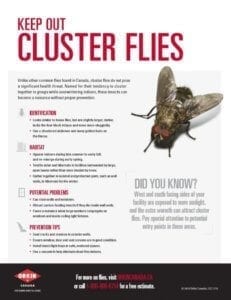Are cluster flies all the buzz around your home or business? With plenty of food, water and shelter, the places we live and work offer ideal habitats for these pests. To keep your property fly-free, you need to keep an eye out for potential points of entry and take preventive measures.
Year-Round Nuisance
While these pests do not pose a significant health threat, they can quickly become a nuisance around your property. Cluster flies are most commonly found around windows and light fixtures and are attracted to organic debris.
Cluster flies appear indoors during warmer months and can leave stains on walls and ceilings where they make contact. These flies are attracted to warm, sunny areas, and facilities surrounded by large, open lawns are susceptible to activity during the summer and fall. Isolated, protected spots like wall voids are the ideal hibernation destination during the winter.
No-Fly Zone
Make sure your space is a no-fly zone by implementing these top prevention tips:
- Seal exterior cracks and crevices
- Ensure window, door and vent screens are in good condition
- Install light traps in safe, enclosed spaces
- Use a vacuum to help eliminate dead flies indoors
Shoo Flies, Don’t Bother Me
Don’t let cluster flies be a bother on your property. Your local Orkin Canada team can help identify potential cluster fly hotspots around your home or facility and create a pest control plan that works for you. For more information on cluster flies, download this quick reference sheet.
You may also like
How To Get Rid Of Flies
With warmer weather around the corner, Orkin Canada is prepared for the pests that come with the warmer weather and melting snow. Everyone is looking forward to flowers blooming, birds chirping, and flies coming in through the open door. Oh wait, not that last one! Flies are a nuisance that no one likes buzzing around inside their home or business. There are many different species of flies; however, they all can cause a threat to your peace of mind, while some are a threat to your health and wellbeing inside your home or business. Whether its cluster flies, house flies, or fruit flies, at Orkin Canada we have 70+ years of expert advice on how to get rid of these unwanted pests. These flies do not stand a chance up against the Orkin Canada technician.
How To Keep Winter Pests Out Of Your Business
In the winter months, competing end-of-year priorities may make pest control more of an afterthought. Probably because pests don’t come around during the colder months, right? Wrong. Pests are opportunistic — when they see your employees enjoying the warmth inside (and possibly some holiday treats in the break room), you can trust they want in on the festivities.
The Buzz on Small Flies
Nobody wants flies buzzing around their business – or their meal. Small flies are not only a nuisance, but they can also risk the health of your employees and customers alike.
Remove pests from your home, and stop them from coming back
We work hard to listen, understand and assess your unique situation. Request a free, no-obligation estimate today for a customized pest program that fits your needs.
Request a Free Home EstimateRequest a Free Business Consultation


